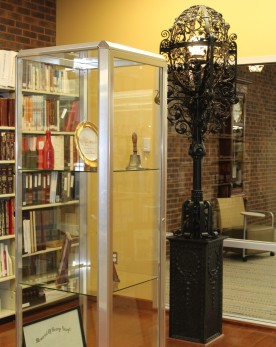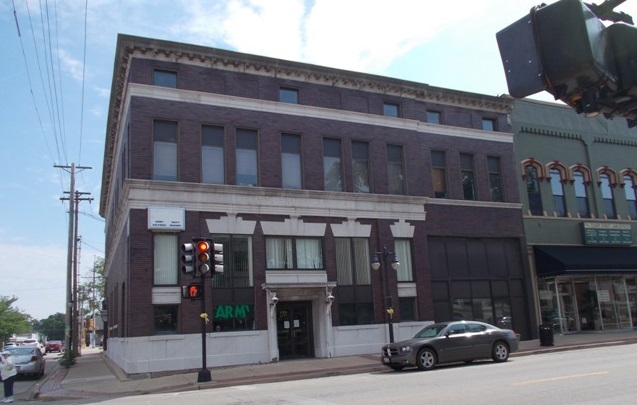By Jared L. Olar
Local History Program Coordinator
As Pekin’s Bicentennial Year continues, this week we’ll take a look back over the history of a downtown landmark that has witnessed almost three-fourths of Pekin’s 200 years: the old Farmers National Bank building at 333 Court St., the northeast corner of Capitol and Court.
The Tazewell County Assessor’s website says the Farmers National Bank building was constructed in 1910, but that was only the date of a major remodeling project that revamped a structure that has existed at least since the 1870s if not earlier. The building, of course, is named for the former Farmers National Bank, one of Pekin’s major financial institutions that operated from 1875 to 1932.
The site on which the Farmers National Bank building now stands has a connection to Abraham Lincoln: in the 1850s a Pekin attorney and justice of the peace named James Harriott (who also served as Pekin’s third mayor in the early 1850s) had his home and law office in the building then located at the northeast corner of Court and Capitol streets. Harriott, who came to Pekin in 1849 from Jersey County, Illinois, was elected a judge of the 21st Judicial Circuit in 1857 and was reelected judge in 1861. As a Pekin attorney and Justice of the Peace, Harriott had dealings with Abraham Lincoln. For example, Harriott was Justice of the Peace in the 1853 case of People v. Thomas Delny, a child rape case that Lincoln successfully prosecuted as Tazewell County State’s Attorney pro tempore.
The 1861 Root’s City Directory of Pekin says Dr. Daniel A. Cheever, homoeopathic physician, then had his office and residence and office at the northeast corner of Court and Capitol, though it’s not clear if the building on that corner in 1861 is the same one in which Farmers National Bank opened 14 years later.
Curiously, the 1871 Sellers & Bates City Directory of Pekin does not mention any business at that location in its business directory, but Farmers National Bank makes its debut in Pekin city directories in the 1876 Bates City Directory, published one year after the bank opened. The 1876 directory lists the bank’s officers as Jonathan Merriam (1834-1919), president, Samuel H. Jones (1823-1907) of Springfield, Ill., vice president, and Alvin B. Hoblit (1844-1920), cashier.
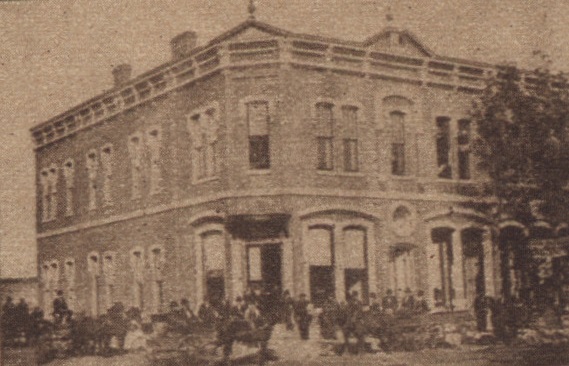



The 1974 Pekin Sesquicentennial, pages 34-35, devotes just two paragraphs to Farmers National Bank. Here is the first paragraph:
“In 1875 the Farmers National Bank was incorporated under the National Banking Law with $50,000 capital. The bank opened with Jonathan Merriam as president, S. H. Jones as vice-president, and A. B. Hoblit as cashier. Other familiar names associated with this enterprise in later years were those of C. R. Cummings, vice-president around 1869 (!), and James M. James, agent of the immense Cummings Estate, president after the turn of the century.”
C. R. Cummings was elected Pekin mayor but left before the end of his term, moving to Chicago where he became a railroad tycoon. Contrary to the Sesquicentennial, Cummings was never a Farmers National Bank officer, but instead was a stockholder and served for a while on the board of directors. His agent, James M. James, was for many years vice president of Farmers National Bank and became bank president in 1911. Upon James’ death on 5 May 1918, the entire city shut down for his funeral, and James Field is named in his memory.
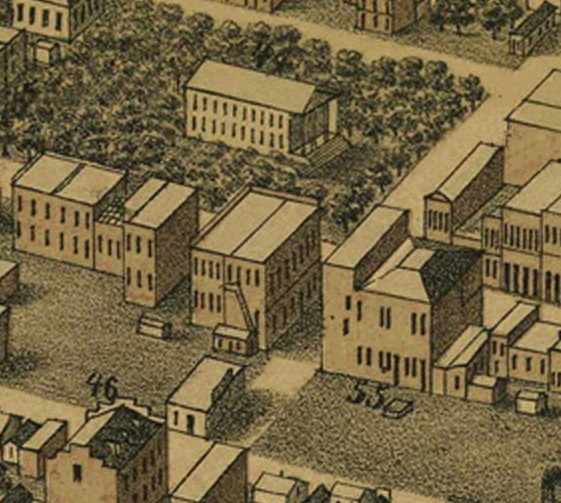
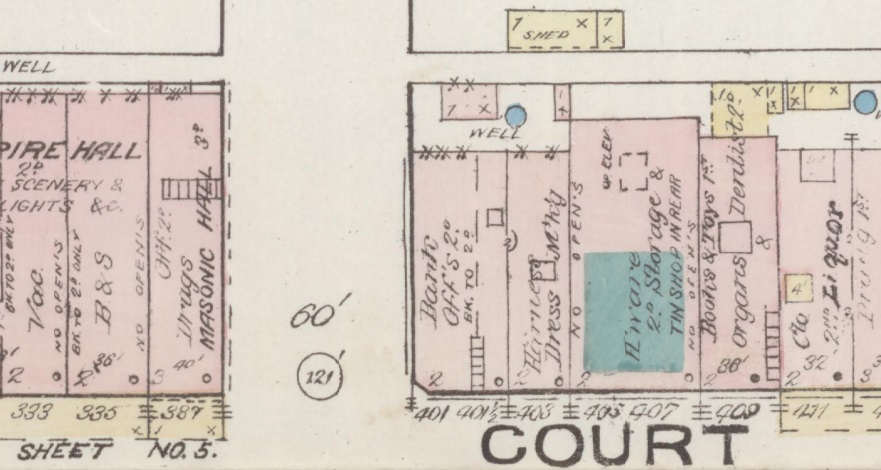

A year after Farmers National Bank appeared in the 1876 city directory, we have a simple sketch of the building in an 1877 aerial view map of Pekin. Then eight years after that, the first Sanborn Fire Insurance Map of Pekin is dated May 1885 and shows Farmers National Bank at “401” and “401 1/2” Court St., because the addresses were numbered differently in those days. Sharing the same building, at “403” Court St. (renumbered “335” Court by 1892) was the harnessmaking business of Charles M. Stickley (1851-1935). Stickley also ran a livery stable at 103 Court St.
Returning to the city directory record, we find that Farmers National Bank took out a full page advertisement in the 1887 Pekin city directory, which lists the bank’s officers then as Frank E. Rupert (1840-1911), president, Flavel Shurtleff (1842-1920), vice president, and Charles H. Turner (1859-1945), assistant cashier. The 1887 directory ad’s list of names is almost a “Who’s Who” of Pekin’s prominent men at the time.
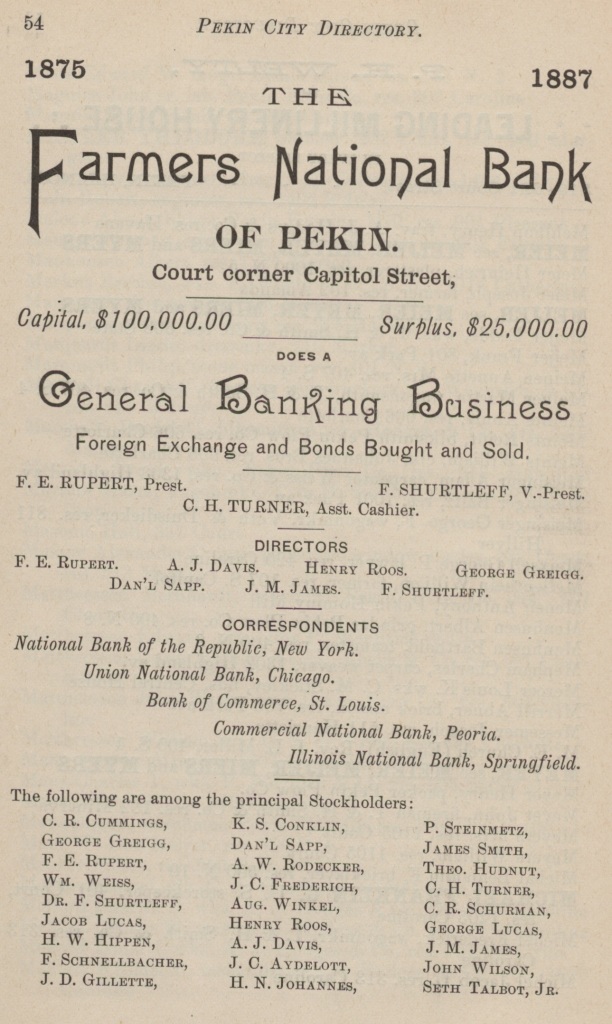


The Jan. 1892 Sanborn Fire Insurance Map and an 1890s photograph show that Charles L. Brereton (1860-1947), merchant tailor, had moved into 333 1/2 Court St. in the Farmers National Bank building, while Stickley’s harnessmaking shop was now being operated by the brothers Charles and William Kuecks (a family better remembered as undertakers and funeral home owners).
In the 1893 Pekin city directory, the bank purchased a front cover advertisement. From then on, Farmers National Bank had a front cover city directory ad almost every year, up to and including the 1930 Polk City Directory of Pekin. The city directories from 1893 to 1904 continue to show the bank at 333 Court, Brereton’s tailoring at 333 1/2 Court, and Kuecks Bros. saddlery and harness at 335 Court.




In the 1908 directory, however, we find Brereton’s tailoring shop replaced by F. M. Conrad’s and E. R. Boxberger’s Five-and-Dime store. The Conrad & Boxberger Five-and-Dime appears at that location only in the 1908 directory, and the Dec. 1909 Sanborn Map shows a carpet store at 333 1/2 Court instead. The 1908 directory also shows that the building space formerly occupied by the Kuecks Bros. saddlery at 335 Court was now the home of a drug store operated by Carl E. Kraeger (1882-1965), who in 1920 was one of the five co-founders of Pekin’s Rotary Club. City directories continue to list Kraeger’s drug store at 335 Court until the 1926 directory, but in the 1928 we see that Kraeger’s has become the Hackler Bros. drug store.
The most important event in this building’s history was the extensive remodeling and refurbishing project of 1910-11, which replaced the buildings Victorian Era façade with the brown brick façade it has borne ever since. The remodeling eliminated the bank’s old corner entrance. This project is commemorated in the stone inscription on the front of the building that gives the dates of Farmers National Bank as 1875 to 1911.
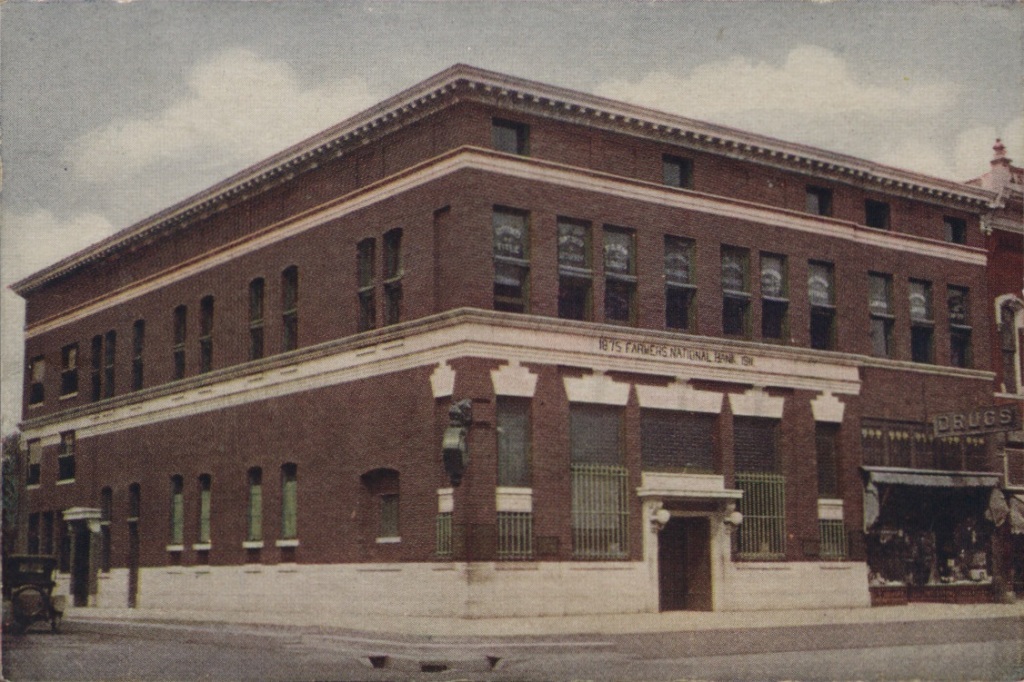
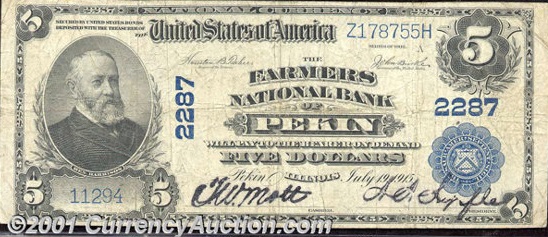



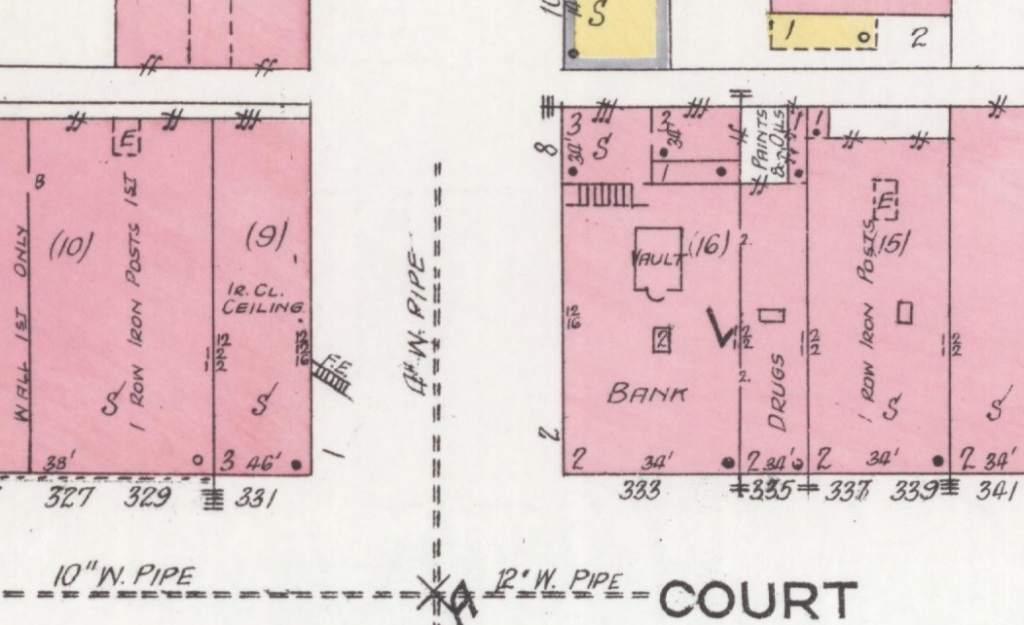
The 1930 Pekin city directory listed the bank’s officers as Arthur A. Sipfle (1874-1952), president (whose wife Mary Caroline was a sister of Carl E. Kraeger), Vincent P. Turner (1853-1933), vice president, Frank F. Riese (1862-1931), vice president, Thaddeus W. Mott (1889-1968), cashier, and Nicholas J. Friedrich (1891-1974), assistant cashier.
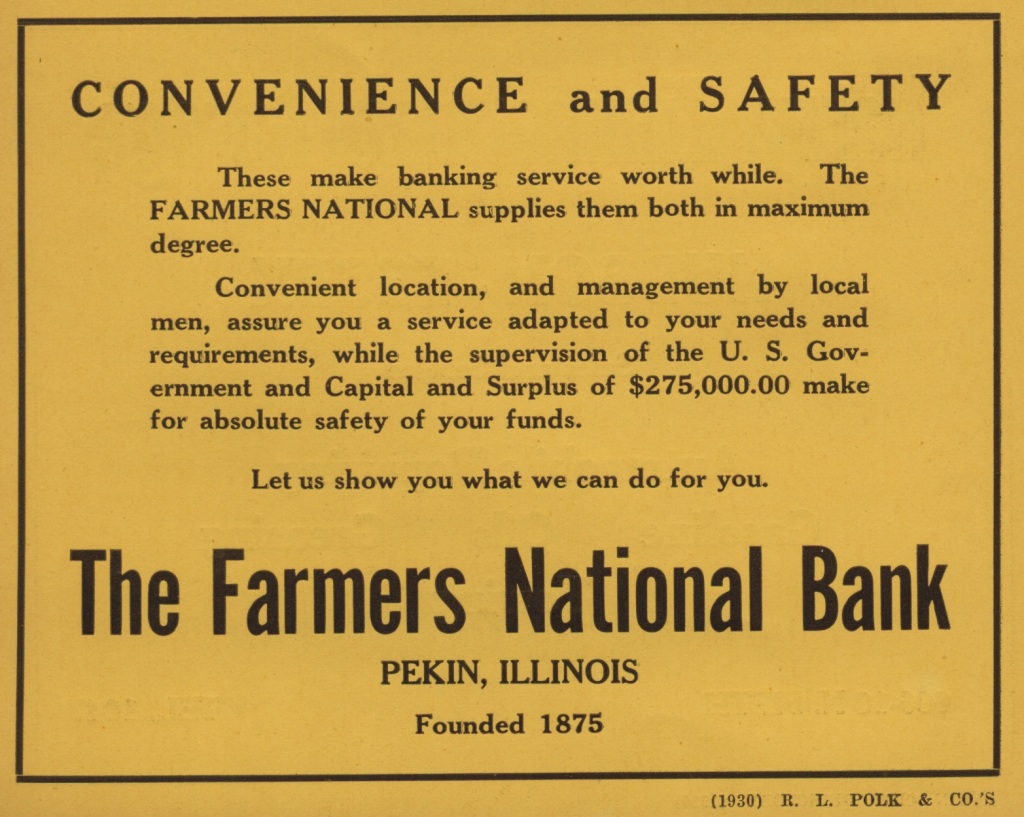
The next city directory, which was published in 1932, had no Farmers National Bank ad on its cover, nor was there even an entry for the bank in the main part of the directory – only a short listing in the Streets and Avenues Directory section of the book. The reason for that is mentioned in the 1974 Pekin Sesquicentennial’s second paragraph about this bank, on page 35:
“Farmer’s National was a financial bulwark for Pekin until 1932, when it closed its doors, supposedly not because of any depression-related crisis or shortage, but simply because it ‘was not making any money’ – we’ll let readers interpret that for themselves. Most depositors eventually got back almost the full amount of their money, but at the time, the closure (sic) smashed public morale, tied up much-needed moneys, and took cash out of circulation for years.”
That summary account of the bank’s closing and the effect it had on Pekin is essentially correct, but contemporary newspaper accounts show that the Sesquicentennial’s comment “supposedly not because of any depression-related crisis or shortage” is not quite correct. The officers and directors made clear on the day that they announced the bank’s closing that the factors leading them to decide to close the bank were all Depression-related. The bank didn’t run out of money, nor was there a run on the bank, but it is undeniably due to the Great Depression that Farmers National Bank failed.
The stock market had crashed less than two and half years before, commencing that period of severe financial woes known as the Great Depression. This period proved exceptionally difficult for Farmers National Bank. The bank’s troubles began with the collapse of farm prices, which put a great strain upon John Fitzgerald (1857-1930) one of the bank’s directors who was engaged locally in the farm loan business. Fitzgerald’s solution was to resort to improper financial dealings that amounted to embezzlement from the bank, for which he ended up serving time in prison.
If Farmers National Bank’s troubles had ended there, it would not have had to close. But the shadow cast by Fitzgerald’s fall, at a time when the national and local economy were depressed, resulted in less business available for the bank: fewer customers, fewer loans, fewer investors, few savings accounts. By the end of 1931, the bank’s officers and directors saw the handwriting on the wall and, ominously, did not send their year-end Bank Statement to the Pekin Daily Times for publication. The bank closed its doors at the end of business, Thursday, 7 Jan. 1932, and later that night, around midnight, the officers and directors agreed the bank would not open for business the next morning.
That afternoon, the Pekin Daily Times ran the banner headline: “FARMERS BANK DECIDES TO LIQUIDATE,” with the subheadline, “’Believe No Depositor Will Lose A Single Center,’ Says Official Statement.” To try to assuage the fears of depositors, the newspaper published “What The Bank Statement Dec. 31 Would Have Been,” along with a statement from Herget National Bank and American National Bank saying that those banks “have reason to believe that all depositors will be paid in full.” F. F. McNaughton, the Daily Times’ publisher, also wrote an editorial that tried to assure everyone that everyone who had money in the bank would get their money. Their assurances proved correct, though in the short term the bank’s failure caused great trouble for many, and for a while the City of Pekin’s government was unable to access about $1 million of city funds that had been deposited at Farmers.

After the closing of Farmers National Bank, the building continued to house not only the Hackler Bros. drug store at 335 Court St., but also provided office space to local attorneys, real estate agents, doctors, dentists, and others in the main office building.
Then in early 1948 came this building’s second major event since the opening of the bank in 1875. On the night of 2 Feb. 1948, a fire of undetermined origin tore through the Farmers National Bank building, completely destroying the Hackler Bros. drug store and the second floor offices in the rest of the building, causing about $150,000 in damage, but the fire spare the main floor offices. Newspaper reports say the blaze was reported at 10:45 p.m. and Pekin firemen, assisted by the Peoria Fire Department, fought the blaze for about seven hours. The hands on the bank’s familiar old clock were frozen to 11:08 p.m., when the fire department cut power to the building.

The fire not only destroyed Hackler Bros., which reopened at 401 Court St., but also displaced attorneys Al Black and Dale Sutton, Elliff and Elliff, and J. M. Powers, dentist Dr. Alan E. Stewart, Dr. Robert Dunlevy, M.D., insurance agent James Cedarquist, Justice of the Peace August Lauterbach, the Pekin Finance Co., JoAnn’s Beauty Shoppe, and the offices of the Cummings Estate occupied by I. E. Wilson.
The building’s owner, Eugene F. Lohnes (1892-1951), who is best remembered as the proprietor of Central Book & Toy at 345 Court St., seems to have passed away before he could have the building’s repairs completed — but repaired it was all the same. By the time of the 1950 Pekin city directory, we only find a listing for Marvin Hecht’s Bonny Shop, a women’s clothing store, at 335 Court St. – Hackler’s was already up and running at 401 Court St. by then. The directory does not show anything else in the Farmers National Bank building that year, but in the 1952 directory we find 333 Court St. reoccupied with several offices.
In 1965, the Farmers National Bank building once again became the home of a local bank. On 8 May 1965, the community-owned Pekin National Bank opened in this building, with Milo A. Miller as president and Gerald E. Conaghan as managing officer and cashier. Pekin National Bank continued to lease the old Farmers National Bank building until 1972, when it moved to a new building of its own at 329 Court.

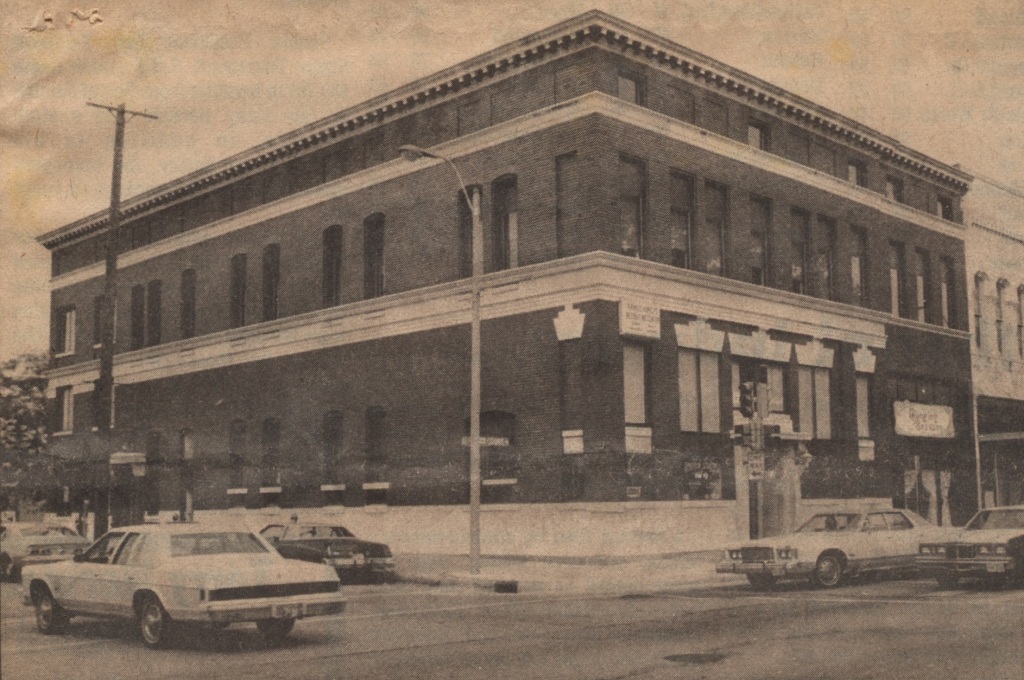
Later this building was acquired by Robert Metzler, and housed the U.S. Army Recruiting Office on its main floor (even today, green Army decals are still visible in one or two windows), with other office spaces on the second and third floors. Over the past two or three decades, the former Farmers National Bank building has had a series of owners, with the current owner listed at the County Assessor’s website being Luis A. Preciado. After everything, the familiar 113-year old brick façade still looks as it did when it was installed in 1911.

